
Malta, officially known as the Republic of Malta and formerly Melita, is a Southern European island country consisting of an archipelago in the Mediterranean Sea. It lies 80 km (50 mi) south of Italy, 284 km (176 mi) east of Tunisia, and 333 km (207 mi) north of Libya. With a population of about 515,000 over an area of 316 km2 (122 sq mi), Malta is the world's tenth smallest country in area and fourth most densely populated sovereign country. Its capital is Valletta, which is the smallest national capital in the European Union by area at 0.8 km2 (0.31 sq mi). The official and national language is Maltese, which is descended from Sicilian Arabic that developed during the Emirate of Sicily, while English serves as the second official language. Italian and Sicilian also previously served as official and cultural languages on the island for centuries, with Italian being an official language in Malta until 1934 and a majority of the current Maltese population being at least conversational in the Italian language.

Valletta is the capital city of Malta. Located in the South Eastern Region of the main island, between Marsamxett Harbour to the west and the Grand Harbour to the east, its population in 2014 was 6,444, while the metropolitan area around it has a population of 393,938. Valletta is second only to Nicosia as the southernmost capital of Europe, and at just 0.61 square kilometres (61 ha), it is the European Union's smallest capital city.

Casa Rocca Piccola is a 16th-century palace in Malta, and home of the noble Maltese family de Piro. It is situated in Valletta, the capital city of Malta. There are daily tours from 10am till 5pm. The palace includes a restaurant called La Giara Restaurant.
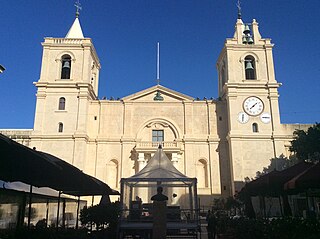
St John's Co-Cathedral is a Roman Catholic co-cathedral in Valletta, Malta, dedicated to Saint John the Baptist. It was built by the Order of St. John between 1572 and 1577, having been commissioned by Grand Master Jean de la Cassière as the Conventual Church of Saint John.
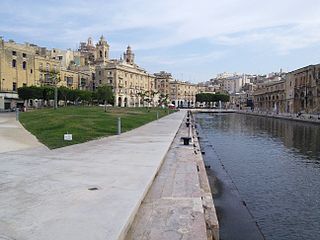
Cospicua, also known by its titles Città Cospicua or Civitas Cottonera, is a double-fortified harbour city in the South Eastern Region of Malta. Along with Birgu and Senglea, it is one of the Three Cities, located within the Grand Harbour to the east of the capital city Valletta. With a population of 5,395 as of March 2014, it is the most dense city of the Three Cities.

Valletta FC is a semi-professional football club based in Valletta, the capital city of Malta, and competes in the Maltese Premier League, the top flight of Maltese football. The club was founded in 1943 after a merge of Valletta Prestons, Valletta St. Paul's and Valletta United, the latter being a two-time league winner before the Second World War.
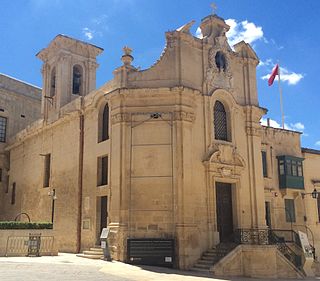
The Our Lady of Victory Church, formerly known as the Saint Anthony the Abbot Church, was the first church and building completed in Valletta, Malta. In 1566, following the Great Siege of Malta, Grand Master Jean Parisot de Valette and his Order showed interest to build a church in the name of the Nativity of the Virgin as a form of thanksgiving; the construction was funded by De Valette.

Christ the Redeemer Church is a church in Valletta, the capital of Malta. It stands as a corner house number 146 on St Christopher Street.
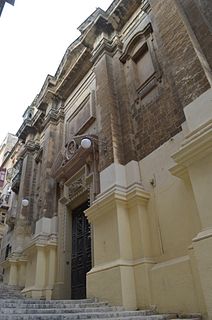
The Franciscan Church of St Mary of Jesus is a church in Valletta, Malta, which is dedicated to St Mary of Jesus and is cared for by the religious order of Friars Minor. It came to be popularly known by the Maltese as Ta' Ġieżu. Ta' Ġieżu is a local corruption of Ta' Ġesù.

The Metropolitan Cathedral of Saint Paul, commonly known as St Paul's Cathedral or the Mdina Cathedral, is a Roman Catholic cathedral in Mdina, Malta, dedicated to St. Paul the Apostle. The cathedral was founded in the 12th century, and according to tradition it stands on the site of where Roman governor Publius met St. Paul following his shipwreck on Malta. The original cathedral was severely damaged in the 1693 Sicily earthquake, so it was dismantled and rebuilt in the Baroque style to a design of the Maltese architect Lorenzo Gafà between 1696 and 1705. The cathedral is regarded as Gafà's masterpiece.
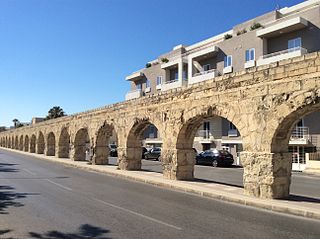
The Wignacourt Aqueduct is a 17th-century aqueduct in Malta, which was built by the Order of Saint John to carry water from springs in Dingli and Rabat to the newly built capital city Valletta. The aqueduct was carried through underground pipes and over arched viaducts across depressions in the ground.

The Auberge de Bavière is a palace in Valletta, Malta. It was built as Palazzo Carneiro in 1696, and it was the residence of Grand Master Marc'Antonio Zondadari in the early 18th century. In 1784, it was converted into the auberge for the Anglo-Bavarian langue of the Order of Saint John, and it remained so until the French occupation of Malta in 1798.

The Auberge d'Italie is an auberge in Valletta, Malta. It was built at various stages in the late 16th century to house knights of the Order of Saint John from the langue of Italy, and it originally had a Mannerist design by Girolamo Cassar and several other architects. The building continued to be modified throughout the course of the 17th century, with the last major renovation being carried out in the 1680s during the magistracy of Gregorio Carafa, giving the building a Baroque character.
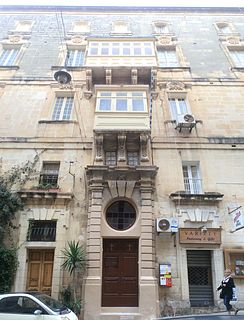
The Church of St George is a Greek Orthodox Church situated in Valletta, Malta. It is one of the orthodox churches in Malta.

The Church of St James is a Roman Catholic church in Valletta, Malta. A previous Mannerist church was built on site in the early 17th-century and demolished in the early 18th-century to built the present baroque church. Built on the designs of Romano Carrapecchia, the church served for religious service to the Langue of Castille. It remain an active church, found in Merchants Street, and it is a scheduled cultural building in a World Heritage Site. The church has a number of artistic features, including its imposing façade and paintings, one drawn by Filippo Paladini and another dating back than the present church itself. Nowadays the church is also used for services by the Ethiopian Orthodox Tewahedo Church and the Eritrean Orthodox Tewahedo Church.

The Basilica of Our Lady of Mount Carmel is a Roman Catholic church in the capital Valletta on the island of Malta. It is one of the most famous churches and main tourist attractions of Valletta, and it forms part of a UNESCO World Heritage site which includes the entire city.

Palazzo Parisio, sometimes known as Casa Parisio, is a palace in Valletta, Malta. It was built in the 1740s by Domenico Sceberras, and eventually passed into the hands of the Muscati and Parisio Muscati families. It was Napoleon's residence for six days in June 1798, during the early days of the French occupation of Malta. The palace was eventually acquired by the de Piro family, and was later purchased by the Government of Malta. It was used as the General Post Office from 1886 to 1973, then the Ministry for Agriculture, and it now houses the Ministry for Foreign Affairs.
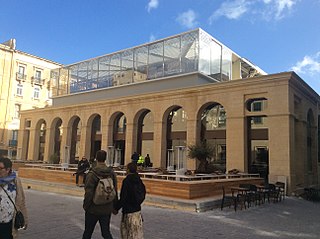
Is-Suq tal-Belt, also known as the Covered Market, is a 19th-century market hall located in Valletta, Malta. It is notable for being the first building in Malta to be constructed mostly of iron. The building was severely damaged in World War II, and the rebuilding was insensitive to the original structure. Further alterations were made in later decades, and the market began to decline in the 1970s. An attempt to rebrand it as a shopping arcade known as Ixtri Malti in the 1980s was unsuccessful. The market continued to decline until it was renovated in 2016–17, and reopened as a food market in January 2018.
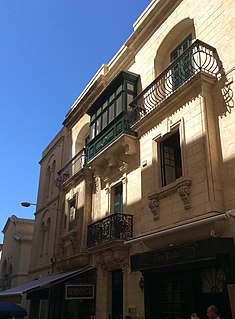
The Malta Postal Museum is a postal museum in Valletta, Malta. It is run by the postal operator MaltaPost, and it was inaugurated on 17 June 2016. The museum is housed in a restored 20th-century townhouse in the centre of Valletta, close to the Grandmaster's Palace and the Church of Our Lady of Damascus.

The Forni della Signoria was a bakehouse, housing a number of bakeries, built during the Order of St John in Valletta, Malta. It was built in the late 16th century, and it produced bread for the inhabitants of Valletta and the surrounding area, as well as for the Order's garrison and navy.




















